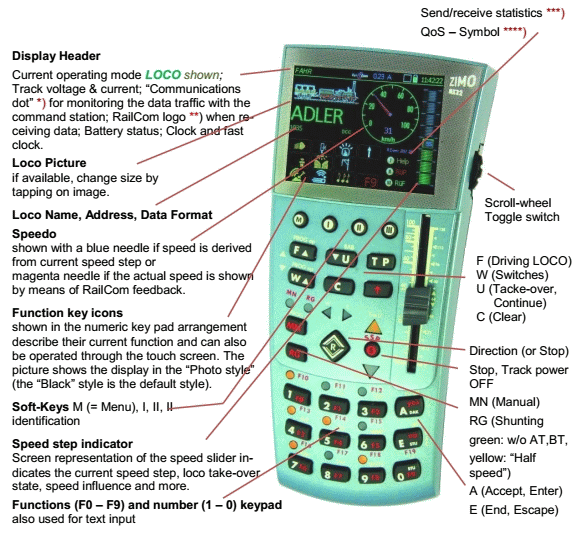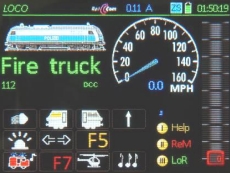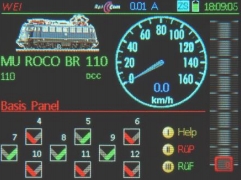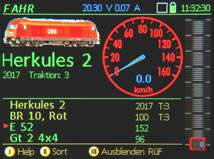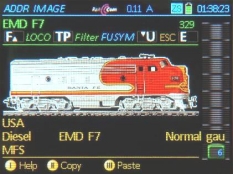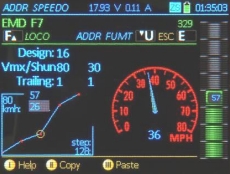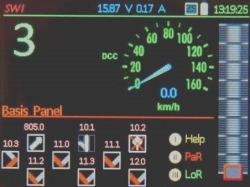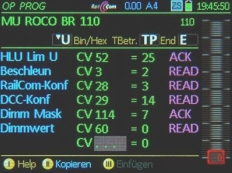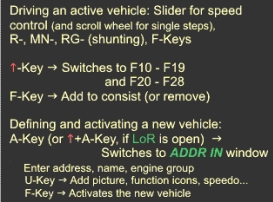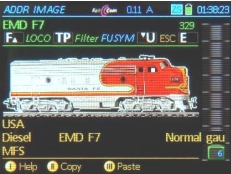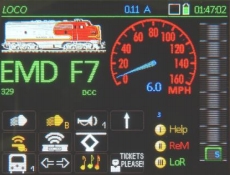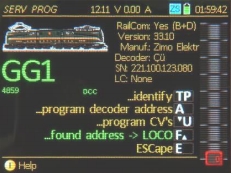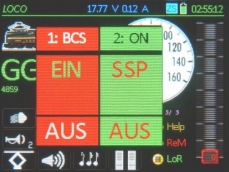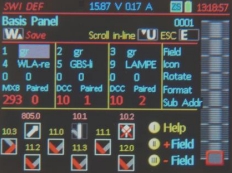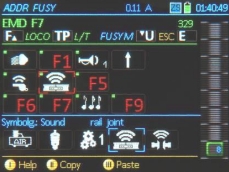- ZIMO Home
- Sound Design
- ZCS
- ZIMO GURU (FAQ)
- Links zu Partner Websites
|
The MX32 Cab (Controller) Go here . . . for information about the MX10 Command Station The MX32. and its wireless version (MX32FU), are the main input devices of digital multitrain control from ZIMO. They are used together with the MX10 as a digital centre (command station), or with its predecessors from ZIMO - MX1, MX1HS, MX1EC, or with the ROCO Center Z21. Technical Data
Current demand (at 20 - 30 V on the CAN Bus Cable )70 mA
to (during battery charging).... 300 mA
Battery in the (non-wireless) MX32 version / in the wireless MX32FU ................... 100 / 2200 mAh Battery life in the (non-wireless) MX32 version / in the wireless MX32FU ................. 15 min / ca. 5h Dimensions Wfront - Wback x Hfront - Hback x L ………………….......................160 x 70 x 20 - 40mm Weight MX32 ……………………………………………………………………………………….. 180 g Weight MX32FU …………………………………………………………………………………… 240 g The Exterior Design of the MX32 Here we have the "ZIMO trademark" of the "crooked" design of the MX31, which has been retained with slight corrections. The basic idea of this form of housing is that the device can be used as a table-top driving desk or as a walk-around hand controller, and this concept has been proven useful for many years among the users. The OLED touch screen with a diagonal of 2.4" and a resolution of 320 x 240 pix is the externally visible innovation of the MX32, and supports, at the same time, the requirement for enhanced functionality and ease of use. Cable Version - MX32 and Wireless Version - MX32FU As with the MX31, the new cab (controller) comes in three versions: 1) as an MX32 for exclusive use on the CAN bus, or 2) as MX32FU with integrated radio module and a permanently installed battery for optional use wireless or via the CAN bus (the battery is charged via the CAN bus cable at the same time), and 3) as MX32ZL, the "central driving desk" with built-in mini command station. The operation is virtually identical in wired or wireless mode; only certain loading functions (photos, larger files, ..) may take longer with wireless connection or are not allowed. In contrast to the "old" system with 433 MHz, the new ZigBee standard uses the 2.4 GHz band for radio communication within the ZIMO system. The network capability of ZigBee causes the forwarding of messages from node to node (ie between the cabs) when a device is located in a radio-shadow. Software Update via USB Stick To make the software update go as smoothly as possible, a USB (host) socket is installed and a commercial memory stick can be connected. This USB stick should contain the file of the new software version downloaded from the ZIMO website). Also, additional collections of loco images, languages, signal diagrams, etc. can all be loaded in this way, via a USB stick. In the future as an alternative, it will be possible tp synchronize these new data files via automatic distribution from the central (MX10) command station (via the CAN bus) to all connected devices, which is especially convenient for layouts with many connected devices. RailCom: In the MX32, there is no special hardware included for "RailCom", because the detectors are in the central command station (global detectors) or supplied by external modules (local detectors). The RailCom information reaches the MX32 on the CAN bus (like all other data). RailCom, is an integral part of the ZIMO system and affects the accuracy of the decoder to make feedback on the system. Of course, operation is also possible with decoders that do not use RailCom; but it is better to use RailCom enabled decoder, i.e. those that report more than just CV values and its own address. This means in practice that updatable decoders are necessarily preferred, so that new software with new features of RailCom can be developed and deployed. RailCom is also a prerequisite for the automatic detection of new locomotives on the layout, which will prevent annoying difficulties associated with forgotten locomotive addresses in the future. The Operating Concept The arrangement of the keys are like the proven MX31. The operating and programming operations offer much more information and comfort due to the larger color displays and high-performance 32-bit microcontroller including large memory (RAM and Flash with more GB): loco images, function icons partially animated, analog speedometer, slider bar, etc. As usual with modern equipment, it is desirable that operation without detailed study of the operating instructions is feasible ("intuitive ..."), which is possible of course. In the current usage, this takes place on screen with information about the current options, for example, the current assignment of the soft keys and other flexibly assigned keys. Moreover, if required, a context sensitive help file appear. Since the MX32 (plus slider Scroll wheel and rocker button) has a complete set of "real" buttons, the touch function of the screen is used primarily for changing the mode of presentation (switch between small and large locomotive photo, switching between speedometer scales, throw points in the future layout displays, etc.). In the operating state "LOCO", thanks to RailCom (with a suitable command station of the new generation) there exists constant contact with the controlled vehicle, as far as decoders and command stations support this: e.g. display the real speed on the screen speedometer, the engine load, the predicted stopping distance. One focus is the operational states "SERV PROG" and "OPMODE PROG", i.e. programming in "Service Mode" or in the "Operational Mode" ("Programming on the Main" - "PoM"). Even 3rd party decoders (by manufacturers other than ZIMO) are supported by the CV handling with command line storage and CV Set management, and ZIMO decoders with expanded scope. RailCom with its function of CV reading in normal operation (i.e. without a programming track) is very helpful here. The operating state "SWI" (Switch mode - WEI in German) summarizes points and signals, regardless of their connection type with different decoders and modules, in "Switch Panels", where they can operate using numeric key or touch. These are planned for the future, in addition to the functions already known from MX31, such as routes and AOS's ("Automated Operation Sequences") , there will also be miniature Layout Panels on handhelds, probably in conjunction with control panel software on the computer, such as STP or ESTWGJ. *) RailCom is a Trade Mark of Lenz GmbH |
|
Translated: 2016-06-24 (German Version: 2015-09-03)







